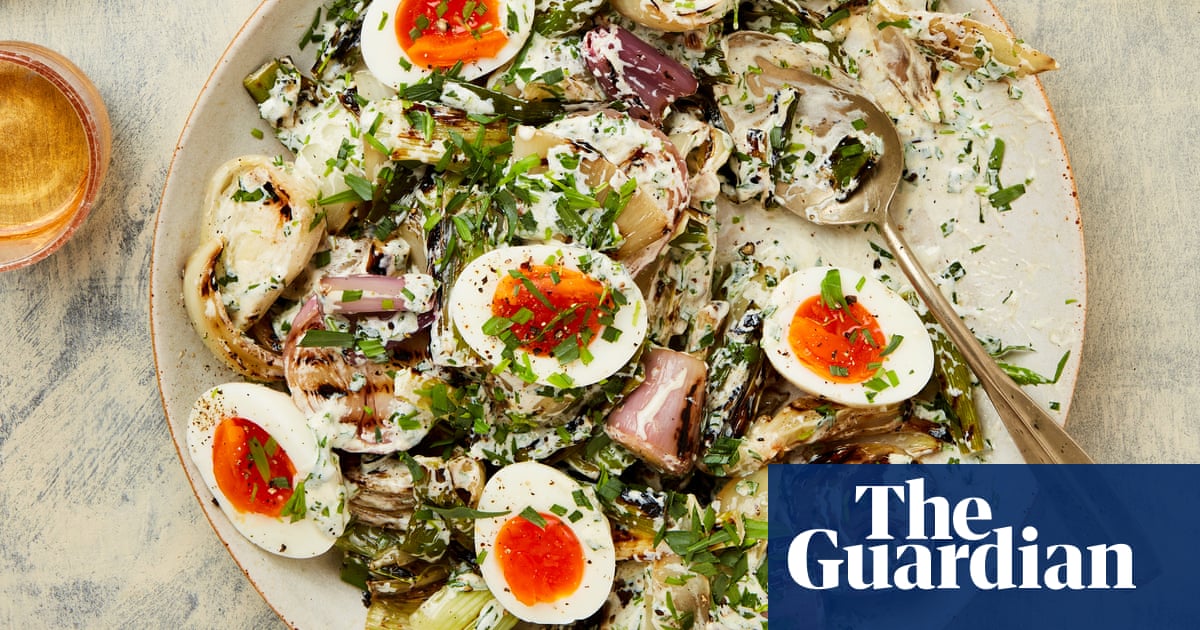It’s the oldest trick in the book: get some onions and garlic on the stove, cook them until they’re smelling lovely, and everyone will assume that dinner is just around the corner. One way to fast-track that process is to make those alliums the stars of the show, rather than just a background note. From shallots to spring onions and chives to calçots, onions and garlic are just two players in the vast and varied allium family. Unlike other vegetables, alliums accumulate energy stores in chains of fructose sugars, rather than starch, and cooking transforms them from harsh to super-soft and sweet. So, instead of making everyone think of supper, think of onions themselves as supper!
Grilled alliums with eggs and tarragon yoghurt (pictured top)
Make the most of the fact that alliums come in all shapes and sizes, because, in combination, the clash of appearance looks great in a finished dish. Stick to just two or three of the four types suggested, if you like, but make sure the total net weight stays about the same.
Prep 20 min
Cook 20 min
Serves 4 as a side
2 Spanish white onions, peeled and each cut into 8 wedges (260g), or use more large shallots (see below)
4 large spring onions (AKA salad onions), trimmed and halved lengthways, then cut into 5cm pieces (260g)
2 large shallots, peeled, trimmed and cut into 3cm rounds (250g)
150g regular spring onions, trimmed and cut into 5cm pieces
60ml olive oil
Fine sea salt and black pepper
3 room-temperature eggs
2 tsp white-wine vinegar
1 tbsp lemon juice
150g Greek yoghurt
1 garlic clove, peeled and crushed
25g tarragon leaves, finely chopped, plus 1 tsp extra to serve
Put a griddle pan on a very high heat. Meanwhile, put all the onions in a large bowl, add two tablespoons of oil and a half-teaspoon of salt, and toss to coat. Once the pan is smoking-hot (this will take a good five minutes), put about a third of the onion mix in the pan in a single layer and without overcrowding the pan. Grill, turning once or twice, for three to five minutes (the exact timing will depend on the size of the onions), until everything is nicely charred, lightly cooked through and translucent; it’s fine if they still have a bit of bite. Take the onions out of the pan as they are done, transfer to a bowl, then repeat with the remaining onions.
Meanwhile, bring a small pan of water to a boil. Add the eggs, turn down the heat to medium-high and simmer for seven minutes. Drain the cooked eggs, run them under cold running water to stop them cooking further and, once they’re cool enough to handle, peel off and discard the shells. Cut each egg in half lengthwise, transfer to a plate and season with a pinch of salt.
Put the remaining two tablespoons of oil, the vinegar, lemon juice, yoghurt, garlic, tarragon, a good grind of pepper and an eighth of a teaspoon of salt in the onion bowl and stir to coat and combine.
Transfer the onions to a serving plate and arrange the egg halves on top. Sprinkle over the extra tarragon, top everything with a good grind of pepper and serve.
Chive and challah bread pudding
An earlier version of this dish from way back in 2013 included asparagus in the mix, but I now prefer to let the chives take the lead. This is a perfect companion for roast chicken, though I could easily eat it on its own with just a few dressed green leaves on the side; it also makes a great brunch dish.
Prep 15 min
Rest 1 hr
Cook 25 min
Serves 8 as a side
80g unsalted butter, diced and left at room temperature
1 garlic clove, peeled and crushed
50g chives, finely chopped
300g stale challah or brioche, crust left on, cut into 1½cm-thick slices (you should end up with about 7 slices)
5 eggs
2 egg yolks
450ml double cream
300ml full-fat milk
¼ tsp ground nutmeg
30g parmesan, finely grated
Fine sea salt and white pepper
200g feta, crumbled
Put the butter, garlic and chives in the bowl of a small food processor, blitz smooth, then spread thinly over one side of each slice of bread.
In a large bowl, lightly whisk the eggs and egg yolks. Add the cream, milk, nutmeg, 20g of the parmesan, three-quarters of a teaspoon of salt and a quarter-teaspoon of white pepper, then whisk to make a custard.
Scatter half the feta over the base of a 25cm x 32cm ovenproof dish, arrange the bread buttered side up on top, then scatter over the remaining feta. Pour in the custard, lay a large sheet of greaseproof paper on top, to cover the pudding completely, then place a smaller heavy rectangular dish on top, to weigh everything down (or top with an oven tray and weigh that down with something heavy). Leave at room temperature for an hour (or, if you want to get ahead, refrigerate overnight).
Heat the oven to 190C (170C fan)/335F/gas 3. Lift the weight off the top of the pudding, then pull off and discard the sheet of paper. Scatter the remaining 10g grated parmesan all over the top and bake for 20-25 minutes, until just set and slightly golden on top. Serve at once.
-
Discover these recipes and over 1,000 more from your favourite cooks on the new Guardian Feast app, with smart features to make everyday cooking easier and more fun

